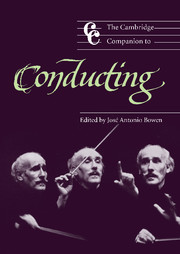2 - Conductors in rehearsal
from Part I - Practice
Published online by Cambridge University Press: 28 September 2011
Summary
Great conductors tend to follow the imperatives of their teachers and apprenticeship, their national musical cultures, and above all the special requirements of their repertoire. Close study of their work reveals no code, conformity, nor Ten Commandments to be found across their individual approaches to rehearsal.
The Conductors on Film Collection at Stanford University has over two thousand hours of some two hundred and fifty conductors in concert, conversation, and rehearsal. From Abbado to Zender, they reveal an extraordinary canvas of action and aesthetic. This chapter will examine the elements of their work that seem to be most successful, vital, and enduring, although much of the (no doubt biased) advice also comes from the author's experience in concert, opera, and recordings. These comments are meant both for young conductors just setting out and for those trying to understand where the real work gets done with an orchestra.
Preparing for the first rehearsal
No serious work is possible without consideration of the performing edition to be employed. Especially since the rise in the mid-twentieth century of the scholar-conductor, it is no longer acceptable simply to hire a full score and go at it. It is essential first to acquire a copy of the manuscript and its variants, and to look into its published history. Many first-class university or conservatory music libraries will have microfilm or microfiche of mainstream repertoire in autograph and first edition. Study these sources closely.
- Type
- Chapter
- Information
- The Cambridge Companion to Conducting , pp. 17 - 27Publisher: Cambridge University PressPrint publication year: 2003
- 4
- Cited by



